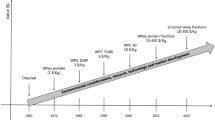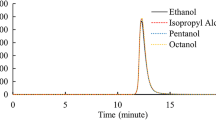Abstract
An optimized fractionation method in the pilot scale for production of isolated α-lactalbumin (α-La) and β-lactoglobulin (β-Lg) was developed. The method comprises following steps: (1) selective thermal precipitation of α-La, (2) aging of the formed particles, (3) separation of native β-Lg from the precipitate via microfiltration and ultrafiltration, (4) purification of β-Lg, (5) resolubilization of the precipitate, and (6) purification of α-La. The native status of the isolated fractions was confirmed by reversed-phase high-performance liquid chromatography (RP-HPLC), sodium dodecyl sulfate–polyacrylamide gel electrophoresis (SDS-PAGE), and differential scanning calorimetry (DSC). Protein fractions with a purity of 91.3% for α-La and 97.2% for β-Lg were produced. These values were based on the native protein detectable in RP-HPLC. High overall yields for α-La between 60.7% and 80.4% and for β-Lg between 80.2% and 97.3%, depending on membrane operation parameters, were achieved. The method offers potential for pilot plant scale and possibly industrial application to produce pure native fractions of α-La and/or β-Lg.










Similar content being viewed by others
References
Alomirah, H. F., & Alli, I. (2004). Separation and characterization of β-lactoglobulin and α-lactalbumin from whey and whey protein preparations. International Dairy Journal, 14(5), 411–419.
Altmann, J., & Ripperger, S. (1997). Particle deposition and layer formation at the crossflow microfiltration. Journal of Membrane Science, 124(1), 119–128.
Basak, S. K., Velayudhan, A., Kohlmann, K., & Ladisch, M. R. (1995). Electrochromatographic separation of proteins. Journal of Chromatography. A, 707(1), 69–76.
Bernal, V., & Jelen, P. (1984). Effect of calcium binding on thermal denaturation of bovine α-lactalbumin. Journal of Dairy Science, 67(10), 2452–2454.
Bobe, G., Beitz, D. C., Freeman, A. E., & Lindberg, G. L. (1998). Separation and quantification of bovine milk proteins by reversed-phase high-performance liquid chromatography. Journal of Agricultural and Food Chemistry, 46(2), 458–463.
Bordin, G., Raposo, F. C., De La Calle, B., & Rodriguez, R. (2001). Identification and quantification of major bovine milk proteins by liquid chromatography. Journal of Chromatography A, 928(1), 63–76.
Bramaud, C., Aimar, P., & Daufin, G. (1995). Thermal isoelectric precipitation of α-lactalbumin from a whey protein concentrate: Influence of protein–calcium complexation. Biotechnology and Bioengineering, 47(2), 121–130.
Bramaud, C., Aimar, P., & Daufin, G. (1997a). Optimisation of a whey protein fractionation process based on the selective precipitation of α-lactalbumin. Le Lait, 77(3), 411–423.
Bramaud, C., Aimar, P., & Daufin, G. (1997b). Whey protein fractionation: Isoelectric precipitation of α-lactalbumin under gentle heat treatment. Biotechnology and Bioengineering, 56(4), 391–397.
Byrne, E. P., & Fitzpatrick, J. J. (2002). Investigation of how agitation during precipitation, and subsequent processing affects the particle size distribution and separation of α-lactalbumin enriched whey protein precipitates. Biochemical Engineering Journal, 10(9), 17–25.
Creighton, T. E., & Ewbank, J. J. (1994). Disulfide-rearranged molten globule state of α-lactalbumin. Biochemistry, 33(6), 1534–1538.
Damodaran, S. (2005). Protein stabilization of emulsions and foams. Journal of Food Science, 70(3), R54–R66.
Duringer, C., Hamiche, A., Gustafsson, L., Kimura, H., & Svanborg, C. (2003). HAMLET interacts with histones and chromatin in tumor cell nuclei. Journal of Biological Chemistry, 278(43), 42131–42135.
Field, R. W., Wu, D., Howell, J. A., & Gupta, B. B. (1995). Critical flux concept for microfiltration fouling. Journal of Membrane Science, 100(3), 259–272.
Gésan-Guiziou, G., Daufin, G., Timmer, M., Allersma, D., & Van der Horst, C. (1999). Process steps for the preparation of purified fractions of α-lactalbumin and β-lactoglobulin from whey protein concentrates. The Journal of Dairy Research, 66(2), 225–236.
Guichard, E. (2006). Flavour retention and release from protein solutions. Biotechnology Advances, 24(2), 226–229.
Gustafsson, L., Hallgren, O., Mossberg, A. K., Pettersson, J., Fischer, W., Aronsson, A., & Svanborg, C. (2005). HAMLET kills tumor cells by apoptosis: Structure, cellular mechanisms, and therapy. Journal of Nutrition, 135(5), 1299–1303.
Hill, A. R., Manji, B., Kakuda, Y., Myers, C., & Irvine, D. M. (1987). Quantification and characterization of whey protein fractions separated by anion exchange chromatography. Milchwissenschaft, 41(11), 693–696.
Jost, R., Maire, J. C., Maynard, F., & Secretin, M. C. (1999). Aspects of whey protein usage in infant nutrition, a brief review. International Journal of Food Science and Technology, 34(5–6), 533–542.
Kerstens, S., Murray, B. S., & Dickinson, E. (2006). Microstructure of β-lactoglobulin-stabilized emulsions containing non-ionic surfactant and excess free protein: Influence of heating. Journal of Colloid and Interface Science, 296(1), 332–341.
Kong, B., Xiong, Y., Cui, X., & Zhao, X. (2011). Hydroxyl radical-stressed whey protein isolate: Functional and rheological properties. Food and Bioprocess Technology. doi:10.1007/s11947-011-0674-8. in press.
Kristiansen, K. R., Otte, J., Ipsen, R., & Qvist, K. B. (1998). Large-scale preparation of β-lactoglobulin A and B by ultrafiltration and ion-exchange chromatography. International Dairy Journal, 8(2), 113–118.
Kühnl, W., Piry, A., Kaufmann, V., Grein, T., Ripperger, S., & Kulozik, U. (2010). Impact of colloidal interactions on the flux in cross-flow microfiltration of milk at different pH values: A surface energy approach. Journal of Membrane Science, 352(1–2), 107–115.
Kulozik, U., & Kersten, M. (2001). Fraktionieren von Proteinen mittels Mikrofiltration. Chemie Ingenieur Technik, 73(12), 1622–1625.
Kuwajima, K. (1996). The molten globule state of α-lactalbumin. The FASEB Journal, 10(1), 102–109.
Laemmli, U. K. (1970). Cleavage of structural proteins during the assembly of the head of bacteriophage T4. Nature, 227(5259), 680–685.
Lucena, M. E., Alvarez, S., Menendez, C., Riera, F. A., & Alvarez, R. (2006). Beta-lactoglobulin removal from whey protein concentrates production of milk derivatives as a base for infant formulas. Separation and Purification Technology, 52(2), 310–316.
Markus, C. R., Olivier, B., Panhuysen, G. E. M., Van der Gugten, J., Alles, M. S., Tuiten, A., Westenberg, H. G. M., Fekkes, D., Kopeschaar, H. F., & De Haan, E. E. H. F. (2000). The bovine protein α-lactalbumin increases the plasma ratio of Trp to the other large neutral amino acids, and in vulnerable subjects raises brain serotonin activity, reduces cortisol concentration, and improves mood under stress. American Journal of Clinical Nutrition, 71(6), 1536–1544.
Markus, C. R., Jonkman, L. M., Lammers, J. H. C. M., Deutz, N. E. P., Messer, M. H., & Rigtering, N. (2005). Evening intake of α-lactalbumin increases plasma Trp availability and improves morning alertness and brain measures of attention. American Journal of Clinical Nutrition, 81(5), 1026–1033.
Matsudomi, N., & Oshita, T. (1996). The role of α-lactalbumin in heat-induced gelation of whey proteins. In N. Parris, A. Kato, L. K. Creamer, & J. Pearce (Eds.), Macromolecular interactions in food technology (pp. 93–103). Washington, DC: American Chemical Society.
Maubois, J. L., Pierre, A., Fauquant, J., & Piot, M. (1987). Industrial fractionation of main whey proteins. Bull Int Dairy Fed, 212, 154–159.
McClements, D. J., Decker, E. A., & Weiss, J. (2007). Emulsion-based delivery systems for lipophilic bioactive components. Journal of Food Science, 72(8), R109–R124.
McGuffey, M. K., Epting, K. L., Kelly, R. M., & Foegeding, E. A. (2005). Denaturation and aggregation of three alpha-lactalbumin preparations at neutral pH. Journal of Agricultural and Food Chemistry, 53(8), 3182–3190.
McLaughlin, J. B. (1993). The lift on a small sphere in wall-bounded linear shear flows. Journal of Fluid Mechanics, 246(1), 249–265.
Muller, A., Chaufer, B., Merin, U., & Daufin, G. (2003). Purification of α-lactalbumin from a prepurified acid whey: Ultrafiltration or precipitation. Le Lait, 83(6), 439–451.
Neyestani, T. R., Djalali, M., & Pezehski, M. (2003). Isolation of α-lactalbumin, β-lactoglobulin and bovine serum albumin from cow’s milk using gel filtration and anion-exchange chromatography including evaluation of their antigenicity. Protein Expression and Purification, 29(2), 202–208.
Orosco, M., Rouch, C., Beslot, F., Feurte, S., Regnault, A., & Dauge, V. (2004). α-Lactalbumin-enriched diets enhance serotonin release and induce anxiolytic and rewarding effects in the rat. Behavioural Brain Research, 148(1–2), 1–10.
Patocka, G., & Jelen, P. (1991). Calcium association with isolated whey proteins. Canadian Institute of Science and Technology Journal, 24(1), 218–223.
Pearce, R. J. (1987). Fractionation of whey proteins. Bull Int Dairy Fed, 212, 150–153.
Piry, A., Kuehnl, W., Grein, T., Tolkach, A., Ripperger, S., & Kulozik, U. (2008). Length dependency of flux and protein permeation in crossflow microfiltration of skimmed milk. Journal of Membrane Science, 325(2), 887–894.
Relkin, P., Liu, T., & Launay, B. (1993a). Effects of pH on gelation and emulsification of a β-lactoglobulin concentrate. Journal of Dispersion Science and Technology, 14(3), 335–354.
Relkin, P., Liu, T., & Launay, B. (1993b). Effect of sodium and calcium addition on thermal denaturation of apo-α-lactalbumin: A differential scanning calorimetric study. Journal of Dairy Science, 76(1), 36–47.
Sawyer, L. (2003). β-Lactoglobulin. In P. F. Fox & P. L. H. McSweeney (Eds.), Advanced dairy chemistry: Proteins, volume 1 (pp. 319–386). New York: Kluwer Academic/Plenum.
Schmitt, C., Bovay, C., Vuilliomenet, A.-M., Rouvet, M., & Bovetto, L. (2011). Influence of protein and mineral composition on the formation of whey protein heat-induced microgels. Food Hydrocolloids, 25(4), 558–567.
Seuvre, A.-M., Diaz, M. A. E., & Voilley, A. (2002). Retention of aroma compounds by β-lactoglobulin in different conditions. Food Chemistry, 77(4), 421–429.
Smithers, G. W., Ballard, F. J., Copeland, A. D., De Silva, K. J., Dionysius, D. A., Francis, G. L., Goddard, C., Grieve, P. A., Mitchell, I. R., Pearce, R. J., & Regester, G. O. (1996). New opportunities from the isolation and utilization of whey proteins. Journal of Dairy Science, 79(8), 1454–1459.
Stănciuc, N., Dumitraşcu, L., Ardelean, A., Stanciu, S., & Râpeanu, G. (2011). A kinetic study on the heat-induced changes of whey proteins concentrate at two pH values. Food and Bioprocess Technology. doi:10.1007/s11947-011-0590-y.
Svanborg, C., Agerstam, H., Aronson, A., Bjerkvig, R., Duringer, C., Fischer, W., Gustafsson, L., Hallgren, O., Leijonhuvud, I., Linse, S., Mossberg, A. K., Nilsson, H., Pettersson, J., & Svensson, M. (2003). HAMLET kills tumor cells by an apoptosis-like mechanism: Cellular, molecular, and therapeutic aspects. Advanced Cancer Research, 88(1), 1–29.
Svensson, M., Hakansson, A., Mossberg, A.-K., Linse, S., & Svanborg, C. (2000). Conversion of α-lactalbumin to a protein inducing apoptosis. Proceeding of the National Academy of Sciences, 97(8), 4221–4226.
Tolkach, A. (2007). Thermisches Denaturierungsverhalten von Molkenproteinfraktionen: Selektive Denaturierung—Fraktionierung mit Membranen—Reaktions-, Auffaltungs- und Aggregationskinetik (Thermal denaturation behaviour of whey protein fractions: Selective denaturation—fractionation with membranes—kinetics of reaction, unfolding and aggregation). Ph.D. thesis. Center of Life and Food Sciences, Technische Universität München, Freising-Weihenstephan, Germany.
Tolkach, A., & Kulozik, U. (2005a). Optimization of thermal pretreatment conditions for the separation of native α-lactalbumin from whey protein concentrates by means of selective denaturation of β-lactoglobulin. Journal of Food Science, 70(9), E557–E566.
Tolkach, A., & Kulozik, U. (2005b). Effect of pH and temperature on the reaction kinetic parameters of the thermal denaturation of β-lactoglobulin. Milchwissenschaft, 60(3), 249–252.
Tolkach, A., & Kulozik, U. (2008). Kinetische Modellierung der thermischen Denaturierung von α-Lactalbumin im sauren pH-Bereich und in Anwesenheit eines Calciumkomplexbildners. Chemie Ingenieur Technik, 80(8), 1165–1173.
Walstra, P., Wouters, J. T. M., & Geurts, T. J. (2006). Dairy science and technology (2nd ed.). Amsterdam: CRC Press Taylor & Francis Group.
Xiang, B., Ngadi, M., Ochoa-Martinez, L., & Simpson, M. (2011). Pulsed electric field-induced structural modification of whey protein isolate. Food and Bioprocess Technology, 4(8), 1341–1348.
Acknowledgments
This research project was supported by the German Ministry of Economics and Technology (via AiF) and the FEI (Forschungskreis der Ernährungsindustrie e. V., Bonn). Project AiF 15834 N. The technical assistance of A. Brümmer-Rolf, E. Dachmann, I. Hager, B. Härter, J. Kupfer, M. Reitmaier and his team as well as T. Steinhauer is gratefully acknowledged. Dr. S. C. Cheison is thanked for stimulating scientific discussions.
Author information
Authors and Affiliations
Corresponding author
Rights and permissions
About this article
Cite this article
Toro-Sierra, J., Tolkach, A. & Kulozik, U. Fractionation of α-Lactalbumin and β-Lactoglobulin from Whey Protein Isolate Using Selective Thermal Aggregation, an Optimized Membrane Separation Procedure and Resolubilization Techniques at Pilot Plant Scale. Food Bioprocess Technol 6, 1032–1043 (2013). https://doi.org/10.1007/s11947-011-0732-2
Received:
Accepted:
Published:
Issue Date:
DOI: https://doi.org/10.1007/s11947-011-0732-2




